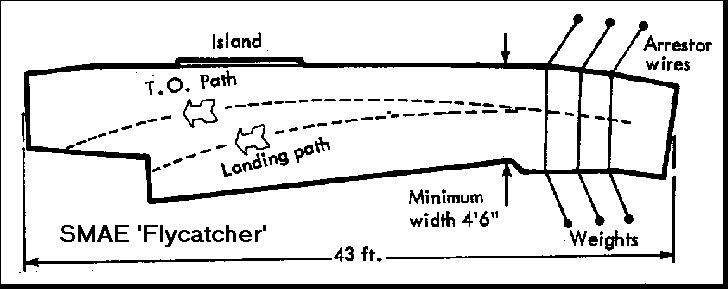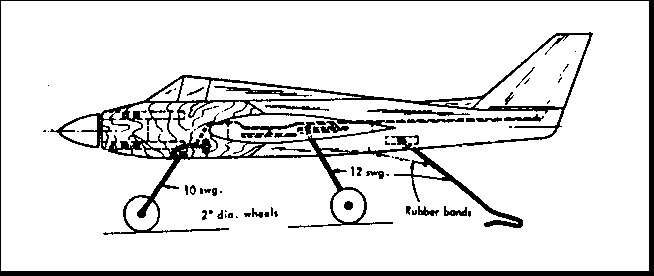
The SMAE 'Flycatcher was a purpose made carrier. There was also a Wolves MAC carrier at about the same period. Both had custom-made trailers to transport them. The Wolves example is believed to be in the Cosford Aerospace Museum.
The history of this event in the UK has been a variable one. At one time the event was quite popular and flown to the then American rules. Models were required to set a high speed time for a set number of laps, followed by the same number of laps flown as slowly as possible, and then to make an arrested landing on an 'Aircraft Carrier'. A formula was then applied which produced a score in points.
Because of the formula used, the premium was on going fast, rather than on the slow section of the flight. To assist with the slow section, various aerodynamic devices, such as flaps, offset ailerons, etc. were used.
A pattern emerged where Mick Reeves, flying his 'Seamew' designs, won most of the events. When Mick moved on to other things, his place was taken by Brian Perry, of the Wolves club. The result of this monopoly was that the event died out. There were a couple of 'Carriers' in existence, which disappeared into mothballs, like their full-size counterparts.

In the recent past, the event has re-emerged, mainly due to the efforts of Andy Hausden, and the Three Kings club, who founded a 'Basic Carrier Deck' class. This required a model conforming to some basic rules with no moving aerodynamic devices and just a profile fuselage. Non-scale models are also allowed to compete. Such is the success of the event that the old 'Class 1' carrier event has also been revived.

It should be stressed that much of the reason for this new found success is that the event has been actively 'sold' and people are encouraged to 'have a go', even if they don't have a suitable model of their own. Other events have much to learn from this - and not just control-line.
Apart from the simpler model, the basic, or 'BCD', class differs from previous events in that the scoring system used puts an emphasis on the slow portion of the flight, rather than the high speed section. The differences may not be immediately apparent, but it is far more difficult (and potentially far more complex) to make a fast model fly slowly than it is to make a slow model fly faster.
Again, the 'BCD' class only has a maximum line length, maximum engine size and a minimum wing area. Other classes need specific line lengths, specific engine sizes, a minimum scale requirement and so on, ad infinitum.
There is no doubt that the basic idea of flying carrier type models off, and back onto, a simulated carrier deck has great appeal. Where it went wrong in the past was in the increasing level of technology and complication that were required to be competitive. Placing the emphasis on flying ability has returned it to popularity.
Some of the areas that were explored in the past included all sorts of moving aerodynamic devices (ailerons, flaps, spoilers) and such things as exhaust throttles coupled to switchable pressure systems. To get more power from an engine you need a large air intake, which needs crankcase pressure, which needs to be turned off when the motor is idling and so on.
It must have been interesting to observe such a system in the air. There would be no real mid range throttle setting - just all or nothing.
The 'Class 1' event has a more rigorous scale requirement and allows moving aerodynamic devices as used by the full-size prototype.
Tuned pipes are not permitted in either class.
It should be noted here that the current BMFA rule book is out of date concerning the carrier events. There you will find three events listed: Carrier, Profile Carrier and Basic Carrier. I haven't compared all of them in detail, but the Basic rules are different to those currently being flown. The terms 'BCD' and 'Class 1' do not appear.
Basic Carrier Deck
The high speed section is timed over 7 laps from a standing start on the carrier deck. The low speed section is also timed over 7 laps. The score is then calculated as follows:
Times will be recorded in seconds to the nearest 1/10th of a second.
Subtract the high speed time from the low speed time.
The resulting number of seconds is expressed as the time difference, in points.
Subtract any deductions from the landing points and add the resulting figure to the time
difference points.
Finally, add any bonus points to produce the overall score.
There is a scale of reductions from the landing points regarding the final attitude of the model and bonus points for scale appearance and a naval colour scheme.
Class 1
The score is the sum of the high speed points, the low speed points, the landing points, and the bonus points (if applicable).
All high speeds will be calculated to the nearest 1/10 mph. High speed points shall be scored the same as speed in mph, and to the nearest 1/10.
Low speed points will be scored as 10 times the ratio of high speed to low speed (10 x high speed divided by low speed).
Landing points have a similar scale of reductions to the basic class. Scale bonuses are based on the requirement that the model is scale within a 5% tolerance.
With a lot of moving surfaces and a good throttle response it should be possible to almost hover the model for the slow speed section. So, in the basic class, apart from no moving surfaces you are not allowed to hover!
How is this enforced? The model is not allowed to assume an angle greater than 30 degrees to the horizon and this is indicated by having a line at this angle marked on the model.
The whole essence of the event is in the landing, since this can account for almost half of the final score. To score full points the model must stop on the deck, on its wheels and with the engine running. Apart from the need to ensure that the model is correctly lined up on the deck, points are lost for any additional laps performed on the approach.
A basic three line control system was shown in an earlier article. There is a commercial system produced by the the J Roberts Company which is quite popular but many flyers produce their own systems. Many articles have appeared on these systems and some of these can be obtained from the source mentioned later.
All models need to be fitted with an arrestor hook which is no longer than one third of the length of the model. This is normally latched in the 'up' position and released by extreme operation of the elevator control.
One possibility which remained unexploited until recently is the electronic throttle control. This is surprising since we are talking about 30 year old technology. This allows the model to be flown on just two lines rather than three, or more. This has obvious advantages in terms of the drag reduction for high speed flight. Whether this would be any real advantage in the 'BCD' class is not so clear, since drag may actually be beneficial for the slow speed section.
Basically the operation of the throttle is by means of an R/C servo. A pulse generator at the handle end 'tells' the servo where to go. With the servo battery located in the model, the lines are only carrying information, not power.
Sophisticated versions of this system have been used for some time in C/L scale models, particularly in the USA, where commercial systems are available. Here the use of an encoder at the handle and a matching decoder in the model allows the operation of several 'channels'.
More details of 3 line control systems and the carrier classes can be obtained from:
Andy Housden, 8 Denmark Road, Kingston upon Thames, Surrey. KT1 2RU.
Tel: 0181 541 0186.
Andy produces a Carrier information pack which can be obtained from him or at any C/L
Carrier meeting. All of this information can also be found on the UK Carrier website at:
http://www.cheffers.co.uk/carrier.html
